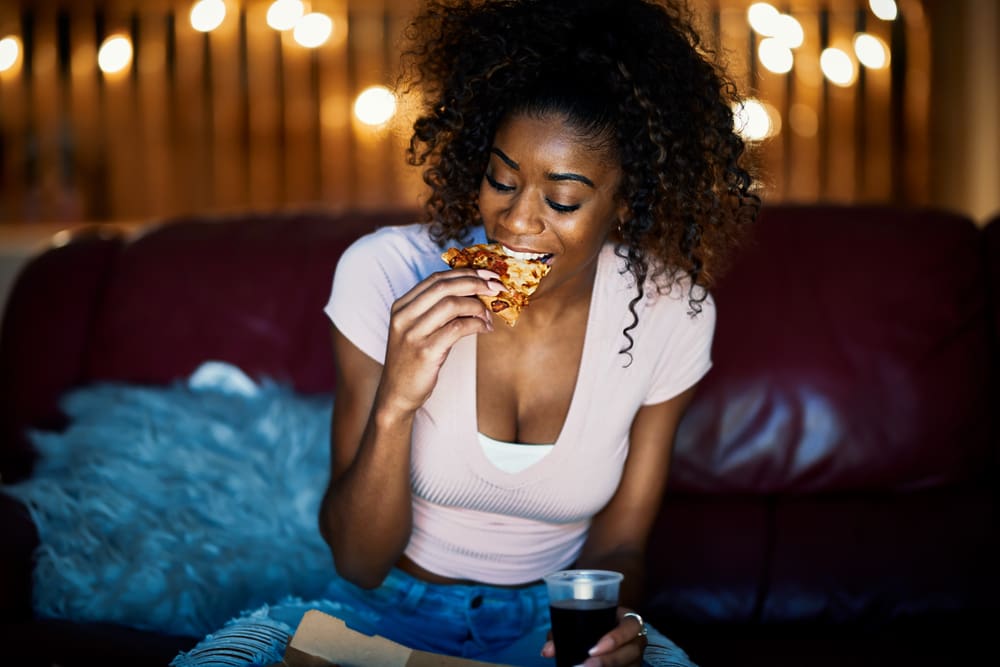You’ve probably noticed it happening. The mindless reach into the chip bag while binging your favorite show. The suddenly empty popcorn bowl during movie night. The mysteriously vanished plate of cookies that were supposed to last all week.
It’s not just your imagination—watching TV really does make you eat more. But the relationship between your screen time and your waistline goes far deeper than simple distraction. What’s happening involves a perfect storm of psychological triggers, evolutionary mismatches, and unconscious behaviors that can add hundreds of extra calories to your day without you even registering them.
Understanding why this happens—and the surprisingly simple ways to counteract it—might be the missing piece in your wellness puzzle. Let’s explore why your brain goes into eating overdrive when the screen lights up, and how breaking this connection can change your relationship with food without giving up your favorite shows.
The attention hijacking that empties your snack bowl
When you’re absorbed in a show, your brain splits its limited attentional resources. This divided attention creates the perfect condition for mindless overeating through several mechanisms that work simultaneously against your best intentions.
Reduced awareness of satiety signals happens almost immediately when you start watching. Your brain’s attention to internal fullness cues diminishes as it processes the visual and auditory information from the screen. Studies show people watching TV take 10-15 minutes longer to register that they feel full compared to those eating without distractions.
Eating memory formation suffers dramatically during screen time. Your brain creates weaker memories of what and how much you’ve eaten when your attention is elsewhere. This memory deficit explains the “where did all the food go?” phenomenon—without clear memories of eating, you’re more likely to continue reaching for more food despite having consumed plenty.
The autopilot effect kicks in where repetitive hand-to-mouth movement becomes disconnected from conscious decision-making. This automaticity explains why you might continue eating long after enjoyment has disappeared, mechanically reaching for the next bite while your attention remains fixed on the screen.
Portion perception distortion occurs when your visual attention shifts away from your plate. Without visual feedback about how much you’ve consumed, your brain relies on less accurate estimates that typically undercount actual consumption by 20-45%. This miscalculation leads to significantly larger portions than you’d normally choose when paying attention.
The eating cessation problem compounds these issues, as natural stopping cues like an empty plate or wrapper get overlooked. Distracted eaters are more likely to continue eating when presented with refills or additional food simply because they didn’t consciously register how much they’ve already consumed.
The reward system confusion your brain can’t resist
Your brain’s reward circuitry evolved long before television existed, creating an evolutionary mismatch that works against your modern health goals. This ancient system gets thoroughly confused by the combination of entertainment and eating.
Dopamine stacking creates an amplified pleasure response when combining two rewarding activities—eating and entertainment. Your brain releases dopamine both from the food reward and from the entertainment stimulus, creating a combined effect stronger than either alone. This heightened pleasure response encourages you to repeat the behavior, strengthening the TV-eating association.
The conditioning loop develops rapidly, where your brain begins to associate watching with eating through repeated pairing. This classical conditioning works the same way Pavlov’s dogs learned to salivate at the sound of a bell—eventually, simply turning on the TV can trigger food cravings through this learned association.
Reward anticipation builds before you even start watching. If you’ve repeatedly paired snacks with specific shows, your brain begins anticipating both rewards simultaneously. This expectation explains why you might find yourself opening the refrigerator almost automatically when settling in for a favorite program, even if you’ve just eaten a meal.
The habituation delay phenomenon means you’ll eat more before feeling satisfied. Normally, food pleasure decreases as you continue eating the same food—a natural mechanism that helps prevent overconsumption. But when your attention is divided, this habituation process slows significantly, allowing you to consume much more before the pleasure diminishes enough to stop you.
Emotional amplification occurs with story-driven content like dramas and movies. Your emotional involvement in the narrative creates physiological arousal that can be misinterpreted as hunger or enhance the perceived pleasure from eating, leading to consumption driven by the emotional experience rather than physical hunger.
The commercial manipulation you can’t see coming
Food advertising creates direct and subtle influences on eating behavior that continue working long after the commercial ends. These effects happen even with recorded shows where you skip the commercials, because many influences are embedded in the programming itself.
Priming effects activate even when you think you’re ignoring commercials. Brief exposure to food images or references triggers cognitive accessibility of food-related thoughts, making you more likely to eat regardless of hunger level. This priming works subconsciously, influencing behavior even when you consciously reject the advertising message.
Integrated marketing within shows has increased dramatically as advertisers adapt to commercial-skipping technology. Product placements and casual food references within programming create similar priming effects without being recognized as advertising. These subtle exposures accumulate throughout viewing time, gradually lowering resistance to eating.
Normalization of portion sizes occurs through consistent visual exposure to unrealistic amounts. Shows consistently depict characters with enormous servings or frequently snacking without consequences, distorting your perception of appropriate portion sizes. This visual programming gradually shifts your own portion norms upward without conscious awareness.
Temporal cues embedded in programming create unconscious eating triggers. Evening shows often feature characters having dinner or drinks, activating your own mealtime associations regardless of your actual hunger level. These contextual eating cues overpower your body’s natural hunger signals.
Commercials themselves influence childhood eating habits that persist into adulthood. Research shows adults who grew up watching commercial television have stronger associations between viewing and eating compared to those who watched commercial-free programming, suggesting early conditioning creates lifelong vulnerability to screen-induced eating.
The social dynamics you didn’t realize were missing
Watching alone eliminates the social constraints that normally moderate eating behavior, creating a unique environment that encourages greater consumption through several social-psychological mechanisms.
Social monitoring absence removes the subtle checking mechanism that occurs when eating with others. Without potential judgment from companions, you’re less likely to monitor your intake in ways that typically happen automatically in social settings. This monitoring effect explains why people typically consume 30-40% more when eating alone while watching compared to eating with attentive companions.
Meal duration extension happens when shows replace conversation. Traditional social meals have natural endpoints as conversation winds down, but TV viewing can extend eating time significantly as you continue through multiple episodes or an entire movie. This extended consumption window allows for much greater total intake than socially-bounded eating occasions.
The performance aspect of eating disappears during solo viewing. When dining with others, subtle performance elements like taking appropriately-sized bites and pausing between them regulate consumption rate. Without this performative component, eating speed typically increases by 30%, allowing significantly more consumption before fullness registers.
Accountability disappears when nobody witnesses your eating. The awareness that others notice your choices creates natural restraint in social settings. Eating alone while distracted removes this accountability completely, enabling consumption that wouldn’t occur if others were present and attentive.
Social synchronization normally regulates eating pace, as people unconsciously match their eating rate to companions. Without this synchronization, solo viewers tend to eat in irregular bursts of rapid consumption rather than the measured pace typical of social meals, leading to greater total intake before satiety signals activate.
The environmental setup that guarantees overeating
Your physical environment during TV viewing creates almost perfect conditions for overconsumption through accessibility, visibility, and arrangement factors that behavioral scientists have thoroughly documented.
Convenience positioning makes a critical difference. Simply placing food within arm’s reach instead of requiring standing up increases consumption by 60-70% during screen time. This proximity effect works by removing the small effort barrier that might otherwise prompt a decision moment about whether you’re actually hungry.
Package visibility triggers eating regardless of hunger. Having food packages visible in your viewing area creates persistent visual cues that stimulate appetite and eating behavior. Research shows merely seeing food packaging throughout viewing time increases consumption independent of hunger levels.
Package size exploitation happens when manufacturers leverage distracted eating. Large-format packaging particularly affects consumption during screen time, with studies showing people consume approximately 30-45% more from larger packages while watching compared to smaller ones, despite feeling they’ve eaten the same amount.
The bottomless container effect occurs with large packages or refillable containers. Without clear visual feedback about how much you’ve consumed, your brain relies on container emptiness as a stopping signal. Larger containers delay this signal, allowing significantly more consumption before triggering the “I should stop” response.
Pre-plating absence removes a critical portion control mechanism. Eating directly from packages eliminates the natural portion control of pre-serving food onto a plate. This direct package consumption is particularly common during TV viewing and dramatically increases intake by removing the conscious decision about portion size.
The body position that changes your digestion
Your typical viewing posture affects digestion, absorption, and satisfaction in ways that increase both consumption during watching and hunger afterward, creating a physiological cycle that promotes overeating.
The reclined eating position common during TV viewing slows gastric emptying by approximately 20%. This position reduces the efficiency of stomach contractions that move food into the small intestine, delaying fullness signals and allowing consumption to continue longer before feeling satisfied.
Slouched posture compresses abdominal organs, potentially slowing digestion and interfering with normal fullness sensations. This compression can delay the gastric distension signals that contribute to feeling satisfied, allowing considerably more consumption before these signals reach threshold.
Reduced movement during extended viewing sessions lowers energy expenditure while simultaneously slowing digestion. This combination creates extended periods of positive energy balance—consuming calories without burning them—compared to more active social activities that might otherwise occupy your time.
Metabolic slowing occurs during lengthy sedentary viewing. Extended sitting reduces metabolic rate below normal resting levels, particularly affecting fat oxidation pathways. This metabolic downregulation means calories consumed during TV time have greater fat-storing potential than those consumed during more active periods.
Digestive efficiency decreases with both reclined position and distracted eating. Studies show nutrient absorption patterns change when eating while distracted in non-optimal positions, potentially triggering earlier hunger return despite adequate caloric intake. This efficiency reduction helps explain why TV snacking often leads to greater total daily consumption rather than compensatory reduction at subsequent meals.
The simple solutions you haven’t tried yet
Breaking the connection between screens and eating doesn’t require giving up your favorite shows or depriving yourself of enjoyable foods. Strategic adjustments can dramatically reduce overconsumption while preserving entertainment pleasure.
The physical separation strategy creates a simple environmental barrier. Designating non-food viewing areas and food-free screening times helps break the automatic association between screens and eating. This separation can reduce screen-related consumption by 60-70% within just 2-3 weeks as the conditioned response weakens.
Pre-portioning before viewing eliminates the bottomless container problem. Measuring out specific portions and putting away packages before settling in to watch prevents the unconscious overeating that happens with direct-from-package consumption. This single habit can reduce viewing-related consumption by 30-50%.
The episode boundary rule creates natural eating endpoints. Limiting eating to between episodes rather than continuously throughout viewing sessions gives your body time to register fullness before the next potential eating opportunity. This intermittent approach typically reduces total consumption by 40% compared to continuous snacking throughout viewing time.
The designated eating spot strategy separates the eating and viewing locations, requiring a conscious transition between them. This physical movement creates a decision point that interrupts automatic eating and provides an opportunity to check in with actual hunger levels before continuing to eat.
The alternative engagement technique keeps hands busy with non-food activities during viewing. Simple activities like knitting, drawing, folding laundry, or using a fidget toy occupy the hands that would otherwise reach for food automatically. This replacement behavior helps break the motor patterns associated with distracted eating.
The mindful commercial break practice turns potential advertising triggers into mindfulness opportunities. Using commercial breaks to check in with hunger levels, practice brief meditation, or simply assess your current satisfaction creates regular interruptions to automatic eating patterns and strengthens awareness of internal satiety cues.
The TV-mealtime separation policy creates a household rule that mealtimes happen away from screens. This boundary preserves the social aspects of eating while allowing guilt-free entertainment at other times, gradually weakening the association between viewing and eating without requiring deprivation of either pleasure.
The relationship between TV viewing and overeating isn’t about willpower or character—it’s about attention, conditioning, and environment. Understanding these mechanisms gives you practical tools to maintain both your entertainment enjoyment and your health goals without constant struggle.
By making strategic adjustments to when, where, and how you combine eating with entertainment, you can break the automatic patterns that lead to mindless overconsumption. The awareness of these connections is often enough to begin changing behaviors that might have seemed mysterious or uncontrollable before.
Your evening entertainment doesn’t have to expand your waistline. With these insights and strategies, you can enjoy your favorite shows without the unwanted side effect of unconscious overeating sabotaging your health goals or diminishing your enjoyment of both food and entertainment.
















